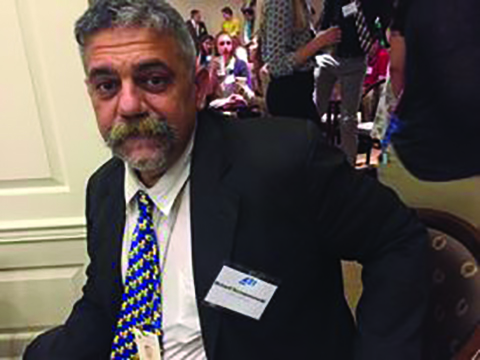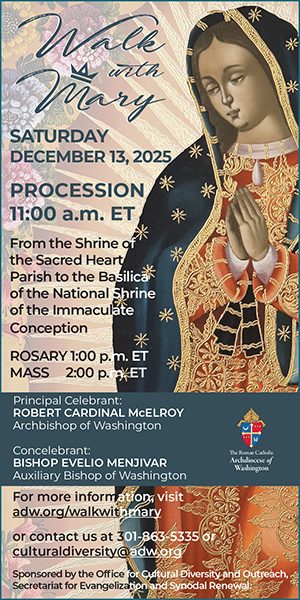When he issued his encyclical Laudato Si’: On Care for Our Common Home in 2015, Pope Francis called on people of goodwill – and indeed, “every person living on this planet” – to demonstrate an “environmental responsibility” that would “directly and significantly affect the world around us.”
Laudato Si’ (“Praise be to You”), was published in June of that year and takes its name from St. Francis of Assisi’s “Canticle of the Sun” in which the saintly friar praises God through His creation and the gifts of “Brother Sun,” “Sister Moon,” and “our sister Mother Earth.” In the encyclical, the Holy Father stressed the need to respect and protect the “relationship existing between nature and the society which lives in it.”
“Nature cannot be regarded as something separate from ourselves or as a mere setting in which we live. We are part of nature, included in it and thus in constant interaction with it,” Pope Francis wrote. “The entire material universe speaks of God’s love, His boundless affection for us. Soil, water, mountains: everything is, as it were, a caress of God.”
In response to the pope’s call for “comprehensive solutions” to address the damage done to the Earth and in celebration of the fifth anniversary of the encyclical, The Roman Catholic Archdiocese of Washington developed a Laudato Si’ Action Plan. The plan outlines ways in which the archdiocese, parishes, schools and individuals can actively respond to Pope Francis’s call to “care for our common home.”
“We are all called to protect our common home according to our ability and means. This Action Plan contains small and big ways for us to exercise stewardship over God’s creation,” Washington Cardinal Wilton Gregory said in an introductory letter to the plan. “I invite each of you to study this Action Plan and be challenged to protect and restore our fragile Earth and our natural resources.”
The Laudato Si’ Action Plan outlines a series of concrete steps that individuals can take to protect the environment. Among the many ideas outlined in the plan to support the environment is a call to increase the tree canopy in the archdiocese. Tree canopy refers to that part of an area or location shaded by trees.
From this sprang “Laudato Trees,” an archdiocesan effort created by the Archdiocesan Care for Creation Committee to make it easy for faith communities to plant trees at no cost to the congregation.
“We have the goal of spreading the message of Laudato Si’ across the archdiocese and encouraging parishes to form green teams,” said Phil Downey, a parishioner of the Cathedral of St. Matthew the Apostle in Washington and a volunteer with the Laudato Trees Team.
The Laudato Trees Team “reaches out to parishes and essentially introduces the idea of planting trees,” Downey said.
“Churches have land, they have property – and that is what you need to plant trees,” he said. “Trees really add a lot to our lives. Trees have a beautiful spiritual analogy. There is an absolute beauty and wonder of creation that we have been absolutely callous in appreciating and nurturing.”
The team brings together arborists and parish officials. The arborists will examine the site, evaluate the property’s space and light conditions and then recommend specific tree species that will thrive in that space. Tree plantings are scheduled for the spring and fall of each year.
“Trees will do an awful lot of restoration work. They lift our spirits and improve our mental health,” Downey said. “Just the beauty of the tree – medical research essentially demonstrates – can help people heal faster. Their spirits will do much better if they are surrounded by greenery and trees and beautiful environments.”
He called tree planting “an act of faith in the future” because “we fully expect these trees to grow and live long lives and shade the churches and provide beautiful places for parishioners for years to come.”

In this effort, the Laudato Trees Team works with Casey Trees, a 20-year-old Washington D.C.-based nonprofit organization committed to restoring, enhancing, and protecting the tree canopy of the nation’s capital.
“We plant trees for the good of the land, for the good of the city, for the good of the ecological impact and for the good of the environment,” said Robert Shaut, director of tree operations for Casey Trees.
Environmentalists, arborists and ecologists have outlined why preserving and expanding tree canopies is important work. They say vibrant tree canopies clean the air, clean water, reduce flooding, reduce air temperature (thus reducing energy bills), increase property values, slow erosion, provide habitat for wildlife, beautify neighborhoods and generally improve the overall quality of life.
“All trees have a positive impact,” Shaut said. “Trees create oxygen and they pull in carbon dioxide. They improve air quality in urban areas because the disparity between concrete and green plant material affects air quality and heat.”
He added that because Washington, D.C. is located on the Potomac and Anacostia Rivers, trees “do a huge piece to mitigate storm water. They have bioretention facilities, they clean water by intercepting and absorbing water that is funneling” toward the rivers.
Shaut and his team have already worked with several Catholic institutions, including Annunciation Catholic Church in Northwest Washington, D.C., and St. Thomas More Catholic Academy in the Southeast section of the city.
“Plant life has always been a very spiritual entity to me. When you think about it, all religions go into nature. There is nothing spiritual about going into a concrete jungle, but go out into the flora and fauna, and it is much more spiritual,” Shaut said in explaining why religious properties are an ideal fit for tree planting. “To me, there has always been a connection between the native environment and spirituality.”
At Annunciation Catholic Church, Casey Trees worked with parish members to plant about 16 trees last fall.
“It’s a wonderful thing to do,” said Msgr. Michael Mellone, pastor of the parish. “Some of those trees have blossomed already. Right now, because the cherry trees are in bloom, the parishioners really like it and truly appreciate it as well.”
That tree planting, he said, spurred the parish’s environmental committee to look into the possibility of establishing a rain garden on the parish grounds. Rain gardens – sometimes called bioretention facilities – are specially designed to collect storm water runoff from driveways or roofs or streets and allow it to soak in the ground. This prevents pollutants in the rainwater from reaching rivers, streams and lakes.
“We are probably one of the few parishes in the city to have a plantable area around it – that is a blessing for us as well as beautification and water retention and good air quality for this area,” Msgr. Mellone said. “So many (city parishes) are surrounded by stone and concrete and don’t have the green space around them. But I say if they have the room to plant trees, they should.”
The priest added that “some of our young people” helped Casey Trees personnel plant the trees and developed an appreciation for care of the environment.
“Tree planting is kind of the first step to ecological conversion. It is a lot of fun and a joyful event,” Downey said. “Something about it gets people a little more in tune and a little more conscious of the precious resource they have in their (parish) real estate. This tree thing can really open our eyes to the wonders and the opportunities around us.”

Young people from St. Thomas More Catholic Academy also joined Casey Tree personnel in planting more than 56 trees on their campus last year.
“This provided us an opportunity as a school and as a parish to be reminded that we have to care for our Earth, our space. To be one of those places that are living out the pope’s vision is pretty powerful,” said Gerald Smith, principal of the school. “For the students, this was an act of service, of giving back to the community and building a space that they will love looking at.”
Pope Francis spoke to this when he wrote in Laudato Si’, “Ecological education can take place in a variety of settings: at school, in families, in the media, in catechesis and elsewhere. Good education plants seeds when we are young, and these continue to bear fruit throughout life.”
Smith said the tree planting fostered in the students an appreciation of the importance of trees and maintaining green spaces.
“They (students) will be able to come back in every season and see the trees grow, and maybe one day they will come back with their own kids and say, ‘See that, I planted these when they were just seedlings’,” Smith said. “And when I drive up and see these beautiful colors (of the trees), I see a campus that people enjoy and want to be a part of.”

Just as at Annunciation Catholic Church, the tree planting at the St. Thomas More led to other initiatives to enhance the environment. Smith said his school plans to plant an additional 12 to 15 trees and is looking into establishing raised garden beds to grow vegetables to donate to the parish food bank.
“One of my joys is knowing that we are giving back to this community visually and spiritually and by feeding them,” Smith said. “This has been a win-win situation for every living thing, and I am indeed one proud principal.”
The school is also preparing to install rain barrels and plant a pollinator garden. Since the tree planting, Smith said, the campus has attracted a colony of monarch butterflies. This is important, because studies have shown that due to a shrinking sustainable habitat, the monarch butterfly population has decreased by slightly more than 50 percent in the last 25 years.
The butterfly population at the school is tangible proof of what Shaut called “the importance of putting the right tree in the right place.”
“We want to plant trees that are native or near native to an area because there is a very symbiotic relationship between pollinators and certain species of trees,” he said.
Downey said the focus on planting native trees is an effort to “support native wildlife.”
“The eco-system is sustained by trees. Basically, if you destroy the native plant habitat, the eco-system is affected,” he said. “Every tree is a thing of beauty and will become a part of this web of life.”
Downey also encouraged the faithful and all people of goodwill to read Laudato Si’.
“Reading and studying Laudato Si’ helps in understanding that everything is interconnected. God has given us this incredibly beautiful and productive world, and He wants us to care for it and not destroy it,” he said. “The pope is telling us every way he possibly can that we need to change course, we have to act and the fate of so many people around the world absolutely depends on it. The poor suffer the most because of environmental devastation. If we are followers of Jesus, how can we not respond to this? It is so compelling and so obvious.”

Pope Francis, in his encyclical, encouraged projects such as that being undertaken by Laudato Trees.
“We must not think that these efforts are not going to change the world. They benefit society, often unbeknown to us, for they call forth a goodness which, albeit unseen, inevitably tends to spread,” he wrote. “Furthermore, such actions can restore our sense of self-esteem; they can enable us to live more fully and to feel that life on Earth is worthwhile.”












